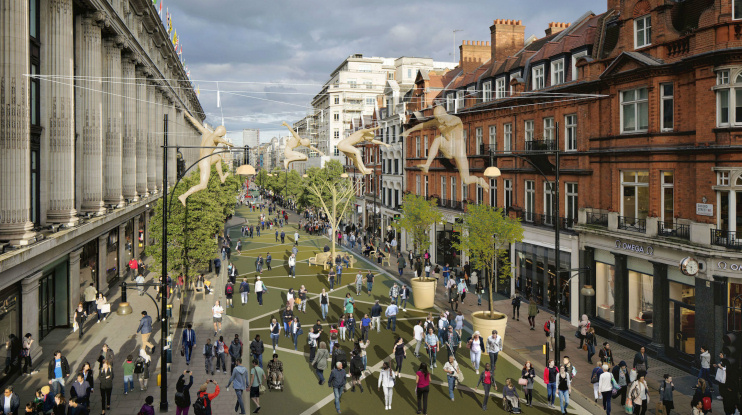Oxford Street
Oxford Street, Westminster
Central London’s “jugular vein of consumerism”, running 1¼ miles east–west from St Giles Circus to Marble Arch

This was a medieval track, part of ‘the way to Uxbridge’, and was formerly known as Tyburn Road. The change to Oxford Street took place gradually between about 1718 and 1729 and the modern name probably derives from former landowners the earls of Oxford.
The Lord Mayor’s banqueting house was a former country seat that stood near the modern Stratford Place, opposite Bond Street station. New Bond Street reached Oxford Street in the 1720s and the banqueting house was demolished in 1737 when private homes, most of which still backed onto open fields, were beginning to line the street.
The neighbourhood’s evolution culminated in the 1810s with the creation of Regent Street, which formed a crossroads at what is now Oxford Circus but was originally named Regent Circus North. Thereafter, small shops such as booksellers, shoemakers and goldsmiths spread outwards from this focal point.
John Lewis opened his first shop selling ribbons and haberdashery in 1864, progressively branching out into new lines. DH Evans followed soon afterwards.
By the 1890s Oxford Circus had become a notorious traffic blackspot, crowded with horse-drawn carriages from dawn until dusk. During this decade the linen draper Peter Robinson relocated here, operating premises at both the north-western and north-eastern corners, while Dickens and Jones took up residence at the south-eastern corner.
The opening of four Central Line stations on the street in 1900 encouraged customers to travel from further afield and in 1902 the Bourne and Hollingsworth brothers-in-law moved their store to Oxford Street from Westbourne Grove, which had been a rival for shoppers’ attentions.
In 1909 Harry Gordon Selfridge opened Britain’s first ‘democratic’ department store, where you could walk around as you pleased rather than being shown from counter to counter.
Oxford Circus was rebuilt over an eleven-year period from 1912 as part of the reconstruction of Regent Street. Oxford Street became single-mindedly devoted to retailing and the last private houses disappeared in 1930, to be replaced by a Gamage’s department store.
Marks and Spencer opened its Marble Arch store in 1930 and the Pantheon store in 1938. By this time, John Lewis’s business had grown to fill a pair of department stores, but these were destroyed by fire after being hit by an oil bomb in 1940. The John Lewis store was rebuilt in its present form in the late 1950s.
The first display of Christmas lights on Oxford Street was turned on in 1959 and the event is now a heavily publicised part of the promotional calendar, usually involving celebrities who appeal to an audience of parents and children. Oxford Circus gets so clogged with shoppers in the run-up to Christmas that police officers are needed to control the pedestrian crossings.
Today the street shifts upmarket from east to west, although the vicinity of Tottenham Court Road station has been revitalised by the arrival of the Elizabeth line. At present, the discount traders are mostly at the eastern end, while department stores and flagship branches of mass-market fashion groups cluster around Oxford Circus. Towards Marble Arch the mix includes hotels and outlets targeting foreign tourists. Much of the south side of Oxford Street is owned by Grosvenor Estates, which has collaborated with Westminster council in making environmental improvements.

Despite receiving backing from London mayor Sadiq Khan, plans to pedestrianise the street (as shown in the CGI above) were withdrawn by Westminster council in June 2018, following public consultations. However, council leader Nickie Aiken was reported as saying: “Doing nothing to improve the area is not an option either if we are to maximise the potential benefits from the opening of the Elizabeth line. We must future-proof Oxford Street and the surrounding district so it … maintains its crown as the nation’s high street in an ever-changing business and retail environment.”
Marks and Spencer’s Pantheon store occupies the site of a pharmacy where the writer Thomas de Quincey obtained his first supply of opium. De Quincey addressed the street as a “stonyhearted stepmother, thou that listenest to the sighs of orphans, and drinkest the tears of children.”
